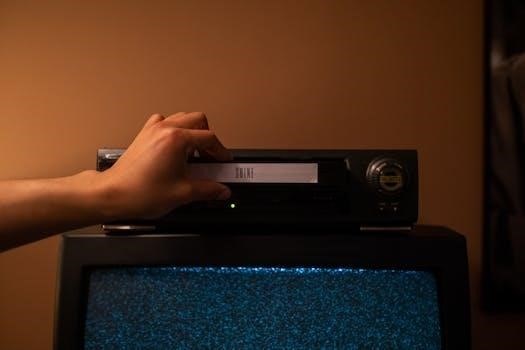The Druck DPI 104 is a precision instrument. Its manual, often in PDF format, is essential for proper usage. This guide provides instructions, safety information, and troubleshooting tips. Understanding this document ensures accurate measurements and prolongs the device’s lifespan.
What is the Druck DPI 104?
The Druck DPI 104 is a high-precision digital pressure indicator, commonly used in various industries for accurate pressure measurement and calibration. It’s a portable, robust device designed to provide reliable readings in demanding environments. This instrument is known for its exceptional accuracy and stability, making it a trusted tool for technicians and engineers worldwide.
Its primary function is to measure pressure with high accuracy, often serving as a reference standard in calibration processes. The DPI 104 can measure pressure in various units, offering flexibility for different applications. It’s widely used in industries such as aerospace, oil and gas, pharmaceuticals, and manufacturing, where precise pressure measurement is crucial;
Furthermore, the Druck DPI 104 features a user-friendly interface, typically including a clear digital display and intuitive controls. Its rugged design ensures durability and reliability, even in harsh conditions. The device often includes data logging capabilities, allowing users to record and analyze pressure measurements over time. The DPI 104 is an indispensable tool for anyone requiring accurate and dependable pressure readings.
Why is the Manual Important?
The Druck DPI 104 manual is crucial for maximizing the device’s potential and ensuring safe, accurate operation. It serves as the definitive guide to understanding all aspects of the instrument, from initial setup to advanced troubleshooting. Ignoring the manual can lead to incorrect measurements, potential damage to the device, and even safety hazards.
The manual provides detailed instructions on proper usage, calibration procedures, and maintenance schedules. It outlines the device’s specifications, limitations, and safety precautions, helping users avoid common pitfalls and ensure accurate readings. Furthermore, the manual contains valuable troubleshooting information, enabling users to diagnose and resolve minor issues independently.
By consulting the manual, users can optimize the DPI 104’s performance, extend its lifespan, and maintain its accuracy over time. It’s an invaluable resource for both novice and experienced users, providing the knowledge and guidance necessary to operate the device effectively. Ultimately, the manual ensures users get the most out of their investment and maintain a safe working environment.

Key Sections of the Druck DPI 104 Manual
The Druck DPI 104 manual is divided into essential sections. These include operation guides, calibration procedures, and troubleshooting tips. Mastering these sections is vital for effective usage. Each section ensures optimal performance and maintenance of your device.
Operation and Setup Instructions
The “Operation and Setup Instructions” section of the Druck DPI 104 manual provides a comprehensive guide to getting started with the device. This section meticulously outlines the initial setup process, ensuring users can correctly configure the device for optimal performance. It covers essential aspects such as power connections, sensor attachments, and initial calibration settings.
Detailed step-by-step instructions walk users through the process of powering on the device, navigating the user interface, and selecting appropriate measurement units. It explains the function of each button and menu option, enabling users to efficiently configure the device for their specific needs. Furthermore, this section includes safety precautions to prevent damage to the device and ensure user safety during operation.
Illustrations and diagrams accompany the text, providing visual aids to clarify complex procedures. The manual also addresses common setup issues and offers solutions to potential problems. By carefully following these instructions, users can confidently set up and operate the Druck DPI 104, maximizing its accuracy and reliability. Properly understanding this section is crucial for avoiding errors and ensuring accurate measurements from the outset, leading to more efficient and effective use of the instrument.
Calibration Procedures

The “Calibration Procedures” section of the Druck DPI 104 manual details the essential steps for maintaining the instrument’s accuracy. Regular calibration is crucial to ensure reliable measurements. This section offers a comprehensive guide, outlining the recommended calibration frequency and the necessary equipment. It describes both automated and manual calibration methods, catering to different user preferences and available resources.
Step-by-step instructions provide clear guidance on performing calibration using certified pressure standards. The manual explains how to connect the DPI 104 to these standards and navigate the calibration menus. It details the process of entering reference values and adjusting the instrument’s readings to match. Furthermore, this section includes information on interpreting calibration results and identifying potential sources of error.
The manual also addresses advanced calibration techniques, such as multi-point calibration, which improves accuracy across a wider pressure range. It emphasizes the importance of documenting calibration results and maintaining accurate records. By following the calibration procedures outlined in this section, users can ensure the Druck DPI 104 consistently delivers precise and dependable measurements, upholding its value as a reliable calibration tool and maintaining confidence in the collected data.
Maintenance and Troubleshooting
The “Maintenance and Troubleshooting” section of the Druck DPI 104 manual provides essential guidance for keeping your instrument in optimal condition and resolving common issues. Regular maintenance is critical for prolonging the device’s lifespan and ensuring accurate performance. This section outlines recommended cleaning procedures, including approved cleaning agents and techniques to avoid damage. It also details how to inspect the instrument for signs of wear and tear, such as damaged connectors or a compromised display.
The troubleshooting portion of the manual offers solutions to frequently encountered problems. It covers issues such as inaccurate readings, display errors, and communication failures. Each problem is accompanied by a list of potential causes and step-by-step instructions for diagnosing and resolving the issue. The manual also includes guidance on replacing consumable parts, such as batteries and pressure modules, and provides information on obtaining genuine replacement parts from authorized suppliers.
Furthermore, this section addresses more complex troubleshooting scenarios, such as internal component failures, and advises users on when to seek professional repair services. It emphasizes the importance of safety precautions when performing maintenance or troubleshooting procedures and warns against attempting repairs beyond one’s expertise. By following the guidance in this section, users can effectively maintain their Druck DPI 104 and resolve common issues, minimizing downtime and maximizing the instrument’s reliability.

Navigating the PDF Manual Effectively
Efficiently using the Druck DPI 104 PDF manual saves time. Learn to utilize its interactive elements. Master the search function for quick answers. Understand the document structure for easy access. This ensures you find information rapidly.
Using the Table of Contents
The Table of Contents (TOC) within the Druck DPI 104 manual PDF serves as a navigational roadmap, guiding users to specific sections with ease. It’s the first point of contact for understanding the manual’s overall structure and content organization.
Begin by familiarizing yourself with the main chapters listed in the TOC; These typically include sections on introduction, safety precautions, operational instructions, calibration procedures, maintenance guidelines, troubleshooting tips, and technical specifications. Pay close attention to the hierarchical structure, often indicated by indentation, which reveals the relationship between main topics and their subtopics.
The TOC allows users to quickly jump to relevant sections without having to scroll through the entire document. Click on a hyperlinked entry to be instantly transported to that page. This feature is especially useful when you need immediate access to specific information, such as calibration steps or error code explanations.
Furthermore, the TOC provides a valuable overview of the manual’s scope. By reviewing the listed topics, users can gain a comprehensive understanding of the Druck DPI 104’s functionalities and capabilities. It also helps in identifying sections that are particularly relevant to your current task or area of interest.
Regularly referring to the TOC can significantly enhance your efficiency in using the manual. It’s a powerful tool for both novice and experienced users, ensuring that you can quickly locate and understand the information you need to operate and maintain the Druck DPI 104 effectively.
Searching for Specific Information
The PDF format of the Druck DPI 104 manual offers powerful search capabilities, enabling users to quickly locate specific information within the document. This feature is invaluable when you need to find details on a particular topic, function, or error code without manually browsing through numerous pages.
To initiate a search, use the “Ctrl+F” (Windows) or “Cmd+F” (Mac) keyboard shortcut, or locate the search icon within your PDF viewer. A search bar will appear, allowing you to enter your search term. Be precise with your keywords to ensure accurate and relevant results. For example, instead of searching for “pressure,” try “pressure calibration” for more focused outcomes.
The search function highlights all instances of your search term within the document, allowing you to quickly identify the sections that contain the information you need. Use the “Next” and “Previous” buttons to navigate through the search results and examine each occurrence in context.
Consider using synonyms or related terms if your initial search yields limited results. The manual may use different terminology than you expect, so exploring alternative keywords can broaden your search and uncover relevant information.
For complex searches, utilize advanced search options, if available in your PDF viewer. These options may allow you to search for phrases, match case, or search within specific sections of the document. Mastering the search function of the PDF manual will save you significant time and effort when seeking specific details about the Druck DPI 104.
Understanding Diagrams and Schematics
The Druck DPI 104 manual often includes diagrams and schematics to illustrate the device’s internal workings, connections, and operational principles. These visual aids are crucial for understanding complex concepts and troubleshooting issues effectively. However, interpreting these diagrams requires a systematic approach and familiarity with basic electronic symbols.
Begin by carefully examining the legend or key associated with the diagram. This section explains the symbols used to represent various components, connections, and signal pathways. Pay close attention to the labeling of each element, as this provides critical context for understanding its function within the system.
Trace the flow of signals or fluids through the schematic, following the arrows or lines that indicate the direction of movement. This will help you visualize the sequence of operations and identify potential bottlenecks or points of failure.
For electronic schematics, understand the symbols for resistors, capacitors, transistors, and other common components. If you are unfamiliar with these symbols, consult a basic electronics reference guide or online resource.
When troubleshooting, use the diagrams to identify the location of specific components or test points. This will allow you to perform targeted measurements and isolate the source of the problem. Cross-reference the diagrams with the troubleshooting section of the manual for additional guidance.
Remember that diagrams are simplified representations of reality. They may not show every detail or component, but they provide a valuable overview of the system’s structure and function. By carefully studying and interpreting these visual aids, you can gain a deeper understanding of the Druck DPI 104 and its operation.

Common Issues and Solutions Found in the Manual
The Druck DPI 104 manual addresses common issues users encounter. These include calibration problems, power failures, and error messages. The manual offers step-by-step solutions, troubleshooting tips, and preventative measures to resolve these issues effectively.
Addressing Calibration Errors
Calibration errors with the Druck DPI 104 can significantly impact the accuracy of pressure measurements. The manual provides detailed procedures for addressing these errors, ensuring reliable and consistent performance. It outlines several potential causes of calibration drift, including environmental factors like temperature fluctuations and humidity, as well as internal component degradation over time.
The manual’s troubleshooting section offers step-by-step instructions for recalibrating the device, often involving the use of traceable pressure standards. It emphasizes the importance of selecting the correct pressure range and ensuring proper connections to avoid introducing further errors during the calibration process. Furthermore, the manual details how to interpret calibration data, identify non-linearity issues, and adjust calibration parameters accordingly.
In some cases, calibration errors may stem from more complex issues, such as sensor malfunction or electronic component failure. The manual provides guidance on identifying these underlying problems and recommends appropriate corrective actions, which may involve contacting a qualified service technician or returning the device to the manufacturer for repair. Regular calibration checks, as recommended in the manual, are crucial for maintaining the accuracy and reliability of the Druck DPI 104.
Troubleshooting Power Issues
Power issues with the Druck DPI 104 can prevent operation. The manual offers detailed troubleshooting steps to resolve these problems, ensuring minimal downtime. Common power issues include the device not turning on, unexpected shutdowns, or a rapidly draining battery. The manual identifies potential causes, starting with simple checks like ensuring the power adapter is correctly connected and the power outlet is functioning.
It guides users through checking the battery’s charge level and replacing it if necessary, emphasizing the use of compatible batteries as specified in the manual. The manual also addresses issues related to the power adapter, including checking for damage to the cable or adapter itself. If the device still fails to power on, the manual suggests inspecting the fuse and replacing it if blown;
For more complex power-related problems, such as internal circuit failures, the manual advises contacting a qualified technician. It warns against attempting advanced repairs without proper training and equipment, as this could void the warranty or cause further damage. Regular maintenance, as outlined in the manual, including proper battery storage and handling, can help prevent power issues and prolong the device’s lifespan. The manual’s troubleshooting section is a valuable resource for diagnosing and resolving power-related problems with the Druck DPI 104.